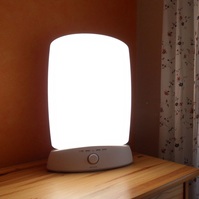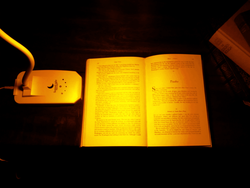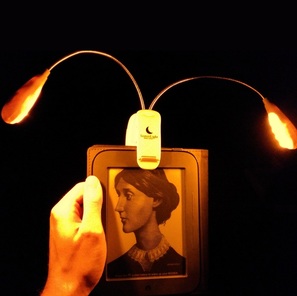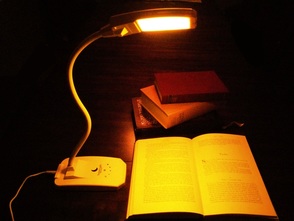What is a sleep lamp? Amber Sleep Lamp Amber Sleep Lamp Broadly speaking, sleep lamps are any device that uses light or light therapy to regulate the circadian sleep cycle. There are two very different types of device commonly called “sleep lamps”: one which emits bright white or blue light in an attempt to establish a clear “wake up” time and another which emits very little blue light in an attempt to establish a clear “winding down” or “sleep time.” Because the human circadian rhythm is controlled almost entirely by light cues (with slight variations for other factors like temperature), both types of sleep lamp are highly effective at establishing consistent sleep schedules and helping to correct circadian sleep disorders like Shift Work Sleep Disorder and Delayed Sleep Phase Syndrome. Wake-up Lights Wake-Up Style Sleep Lamp Wake-Up Style Sleep Lamp The most common device referred to as a sleep lamp should more appropriately be called a Wake-up light. Wake-up lights were originally used to treat circadian mood disorders like Seasonal Affective Disorder (SAD), for which they have proven very effective. Wake-up lamps are also called SAD lamps and Happy Lamps (Dawn Simulators are a variation which includes an alarm and gradual brightening features). These lights, which are either blue or white, emit a high percentage of blue wavelengths in order to replicate the effect of morning and afternoon sunlight when natural light would not be possible (particularly in the winter or in an office building). When blue wavelengths from either natural or artificial sources hit our retinas, it sends a very strong signal for our bodies to stop producing the sleep hormone melatonin and begin producing wakeful hormones like serotonin and cortisol. Wake-up lights should be used in the early morning and throughout the early afternoon to firmly establish this time as the beginning of the circadian cycle. While Wake-up lamps do not directly result in better sleep, they can push the circadian cycle earlier, allowing you to become tired at an earlier and more consistent time of night. Because melatonin, serotonin, and cortisol help regulate not only in sleep but also mood, anxiety, and immune function, a properly attuned circadian rhythm is essential for general health and wellness. For a look at the hazards of an improperly attuned circadian cycle, see our articles on Melatonin and Cancer, and Melatonin and Shift Work. Excessive blue light at night has also been linked to ADHD Insomnia, Bipolar Insomnia, and blue light insomnia. (Low-blue) Amber Sleep Lamps Amber Lights Help Preserve Melatonin Production Amber Lights Help Preserve Melatonin Production On the other end of the spectrum are amber sleep lamps. While blue light in the morning is essential for waking us up and beginning the circadian cycle, blue light at night can have an extremely detrimental effect on the circadian rhythm, leading directly to blue light insomnia, Shift Work Sleep Disorder, and Delayed Sleep Phase Syndrome. Most modern lighting and communication devices emit an incredibly high percentage of blue wavelengths, leading to a modern uptick of blue light insomnia and related sleep disorders. In fact, a modern smart phone screen emits a higher percentage of blue wavelengths than an afternoon sky. One study found that exposure to a typical reading lamp (100 lux) resulted in a 50% decrease in melatonin production. Another study found that exposure to blue light at night can push back melatonin production by an average of 90 minutes and delay sleep for roughly an hour.  Amber Sleep Lamp Emissions Amber Sleep Lamp Emissions In contrast, amber sleep lamps use native amber LEDs, which emit a smaller percentage of melatonin-blocking blue wavelengths than any other lighting source. Unlike blue light, even very bright amber light (800 lux) has been found to have no negative effect on nighttime melatonin production. Our bodies interpret amber light as “virtual darkness” allowing for unimpeded, healthy melatonin production. Just as bright wake-up lights help to set the altering stage of our circadian cycle, amber lamps help to trigger the restful portion of the sleep cycle. Over the past two decades, numerous studies have found that limiting one’s nighttime light exposure to long amber wavelengths results in earlier sleep times, deeper sleep, and less morning anxiety. Both categories of sleep lamp can be used independently to help correct various circadian sleep disorders, though the most successful practices include consistent use of bright, blue light in the morning and dim, amber light in the evening. The results could be beneficial to not only your sleep, but to your mood and overall health as well. You can find amber sleep lamps and nursery lamps here.  Amber Nursery Light Amber Nursery Light Sources: Duffy, J.F. and Czeisler, C.A. (2009). Effect of Light on Human Circadian Physiology. Sleep Med Clin., (2), 165-177. Gooley, J. J., Chamberlain, K., Smith, K. A., Khalsa, S. B. S., Rajaratnam, S. M. W., Van Reen, E., … Lockley, S. W. (2011). Exposure to Room Light before Bedtime Suppresses Melatonin Onset and Shortens Melatonin Duration in Humans. The Journal of Clinical Endocrinology and Metabolism, 96(3), E463–E472. doi:10.1210/jc.2010-2098 Jamie M Zeitzer, Derk-Jan Dijk, Richard E Kronauer, Emery N Brown, Charles A Czeisler J Physiol. Sensitivity of the human circadian pacemaker to nocturnal light: melatonin phase resetting and suppression. 2000 August 1; 526(Pt 3): 695–702. doi: 10.1111/j.1469-7793.2000.00695.x PMCID: PMC2270041 https://sleepfoundation.org/insomnia/content/light-therapy-insomnia-sufferers
8 Comments
 SomniLight Amber Book Light SomniLight Amber Book Light At first glance, it sounds too good to be true. How can simply reading with an amber book light before bed reduce sleep anxiety, improve sleep quality, and help you fall asleep up to an hour faster? In fact, reading with an amber book light actually incorporates the most essential elements of Cognitive Behavioral Therapy for Insomnia (CBT-I), the first-line treatment for chronic insomnia as recommended by sleep specialists. A 2015 meta-analysis of 20 independent studies determined that Cognitive Behavioral Therapy for Insomnia was actually as effective as prescription sleeping pills (benzodiazepines and Ambien) for short-term treatment of insomnia and a better treatment for chronic insomnia in the long term, with none of the grogginess, dependency, and rebound insomnia associated with hypnotic drugs. During the 20 CBT-I studies, the average participant fell asleep 19 minutes faster with a 9.9% increase in sleep efficiency (Trauer, 2015). A recent survey revealed that 48% of Americans suffer from nightly or occasional insomnia. It’s time we started taking drug-free treatments like CBT-I more seriously. Cognitive Behavioral Therapy may sound overly complicated, but many of the techniques can be achieved simply by reading each night with an amber book light. Amber Light and Sleep Hygiene. Native Amber Book Light Native Amber Book Light An essential part of CBT-I is sleep hygiene--following a few simple rules that add up to an ideal sleep environment. These rules include: avoiding alcohol and caffeine before bed and sleeping in a cool, dark room with the addition of white noise. Arguably, the most important aspect of sleep hygiene is eliminating your exposure to bright light, and particularly to blue light, before bedtime. Blue wavelengths of light from cell phone screens, computer screens, and overhead lighting trick your body into thinking it’s daytime. Even relatively small levels of blue light at night (a single bedside lamp) can block production of the powerful sleep hormone melatonin by over 50%. Brighter lights can block up to 100% of melatonin production. Warmer light sources, like candle flames and very warm incandescent bulbs, contain a lower percentage of blue wavelengths, while cooler light sources, like eco-friendly fluorescent blubs, the LCD screens on our digital devices, and white LEDs contain very high levels of melatonin-blocking blue light. However, like lasers, native Amber LEDs emit only a very narrow spectrum of amber light; according to one study, “application of even bright (800 lux) amber light had no negative effect on melatonin production” (Kayumov et al). Switching to amber light at night allows your body to produce healthy levels of melatonin, relieving insomnia and improving overall sleep quality. Read in-depth research about blue light insomnia here and the health hazards of melatonin deficiency here. Reading as Stimulus Control.Another important aspect of CBT-I is stimulus control. This means removing all hyper-stimulating devices from the bedroom environment. Ideally, you should not watch T.V., listen to loud music, or browse the internet, both immediately before bed and in your bedroom during the day. Over time, performing these stimulating, wakeful activities in your bedroom will create a mental association between the bedroom and wakefulness. Instead, most CBT-I practitioners recommend a more relaxing pre-bedtime routine, like knitting or reading (some practitioners go so far as to recommend reading “a dull book,” though I would suggest fantasy fiction, as I’ll explain). A low-stimulus bedroom routine not only helps your mind and body unwind at night, it eventually creates positive, restful associations with the bedroom. Readings as Relaxation. Warm Amber Reading Lamp Warm Amber Reading Lamp At night, when the normal stimuli of your everyday life aren’t there to distract you, it’s easy to fall into a negative spiral of anxiety about your daily troubles. Is the rent due tomorrow? Did I leave the stove on? Will I get passed over for that promotion? Dwelling on these negative thoughts can exacerbate insomnia, and lead to even more negative associations with bedtime. Moreover, many who suffer from insomnia also suffer from sleep anxiety or “Somniphobia,” the fear of sleeping or (more often) the fear of not sleeping. Will I ever be able to fall asleep? What time is it? How many hours will I get if I fall asleep now? CBT-I typically encourages mindfulness techniques like breath-based meditation or guided imagery meditation in order to ease the mind away from negative cycles of thought. However, I find reading to be an even more effective method of bedtime relaxation. For me, falling into one of Tolkien’s charming descriptions of Middle Earth’s landscape is the best “guided imagery” I could hope to find. Worrying about the troubles of a hapless Hobbit helps gently ease my mind away from my own daily stressors. All-in-all, I would recommend reading with an amber book light or amber reading lamp as a fun and easy primer into Cognitive Behavioral Therapy for Insomnia. Has reading before bed, particularly by warm light or amber light, helped you manage your insomnia? Do you have any nighttime reading suggestions for the growing masses of amber book light readers? Leave your suggestions in the comments below! Read reviews of our book lights here and related research into Blue Light Insomnia, ADHD Insomnia, Bipolar Insomnia, Melatonin and Cancer, and Shift Work Sleep Disorder here. Sources: Jamie M Zeitzer, Derk-Jan Dijk, Richard E Kronauer, Emery N Brown, Charles A Czeisler J Physiol. Sensitivity of the human circadian pacemaker to nocturnal light: melatonin phase resetting and suppression. 2000 August 1; 526. https://sleepfoundation.org/sleep-news/cognitive-behavioral-therapy-insomnia https://www.lowbluelights.com/sleep.asp |
AuthorJordan Burr teaches on the subject of "Technology and Culture" at the University of Kansas. ArchivesCategories |

 RSS Feed
RSS Feed